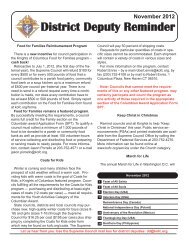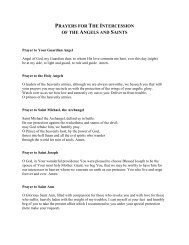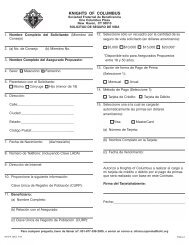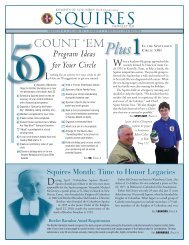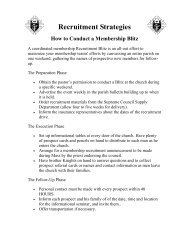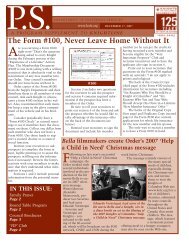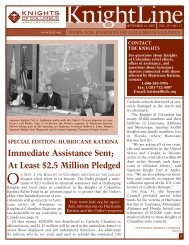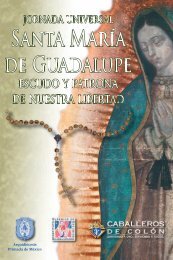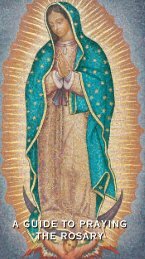Financial Secretary Handbook - Knights of Columbus, Supreme ...
Financial Secretary Handbook - Knights of Columbus, Supreme ...
Financial Secretary Handbook - Knights of Columbus, Supreme ...
Create successful ePaper yourself
Turn your PDF publications into a flip-book with our unique Google optimized e-Paper software.
Member billing attempts have been returned to<br />
us as undeliverable. How do we proceed with the<br />
retention/suspension process?<br />
You must make a good-faith attempt to contact the<br />
member, including filing the Notice <strong>of</strong> Intent to<br />
Suspend, as filing that form initiates state council<br />
retention efforts. If attempts to contact fail, you can<br />
submit a Form 100 for suspension with a notation<br />
“unable to contact” listed as the reason.<br />
I submitted withdrawal letters but they were<br />
returned with a notation that they appeared to be<br />
“form letters.” If a member will not write a<br />
letter, why can’t the council write it and the have<br />
the member sign?<br />
While some decisions regarding withdrawal<br />
requests are subjective, the <strong>Supreme</strong> Council <strong>of</strong>fice<br />
must be convinced that the member – not the council –<br />
initiated the request.<br />
How do I obtain membership numbers and<br />
degree dates for members entering my council by<br />
transfer or re-entry?<br />
If membership numbers and/or degree dates are not<br />
available at the time <strong>of</strong> application, you can submit the<br />
Form 100 without them. Simply include on the form<br />
what information you have available. In the case <strong>of</strong><br />
transfer, this information will usually be provided by us<br />
or the former council on the Transfer Account<br />
Adjustment Form 142. If not – and in the case <strong>of</strong> reentries<br />
– check the council roster on the Order’s website.<br />
Web-based rosters are updated weekly.<br />
I see a credit on my council statement for $7.50<br />
($5.00) with a name and number for a member<br />
that has not applied for re-entry into our council<br />
or left our council by suspension or withdrawal<br />
some time ago. Why are we receiving this credit?<br />
The member has re-entered the <strong>Knights</strong> <strong>of</strong><br />
<strong>Columbus</strong> through another council. That council was<br />
responsible for collecting the re-entry fee, which is<br />
passed along to your council by the credit appearing on<br />
your monthly statement.<br />
What are inactive members, and why do they<br />
appear on my council’s roster?<br />
Inactive members are insurance members in an exit<br />
status, either by suspension or withdrawal, and thus<br />
are no longer in good standing in the Order. However,<br />
because they have in-force <strong>Knights</strong> <strong>of</strong> <strong>Columbus</strong> insurance,<br />
they are retained on your rolls to satisfy the<br />
requirements mandated by the insurance commissioners<br />
in the various jurisdictions we serve. Inactive members<br />
are subject to <strong>Supreme</strong> and state-levied assessments.<br />
To help <strong>of</strong>fset these assessments, we credit<br />
your account $9.00 annually for each. The inactive<br />
member will remain in that status until such time as he<br />
reactivates his membership in yours or another council<br />
or he is no longer insured under a <strong>Knights</strong> <strong>of</strong> <strong>Columbus</strong><br />
policy.<br />
What are the differences between the various<br />
forms <strong>of</strong> re-entry: reinstatement, reactivation,<br />
readmission and reapplication?<br />
Full definitions for these four re-entry transactions<br />
are found on page 51 <strong>of</strong> this handbook. However, when<br />
reporting a re-entry transaction to the <strong>Supreme</strong><br />
Council <strong>of</strong>fice, the financial secretary shouldn’t be<br />
overly concerned with which transaction is appropriate,<br />
as the member’s master record at the <strong>Supreme</strong><br />
Council <strong>of</strong>fice shows how he left and how long he has<br />
been out <strong>of</strong> the Order. The system then determines the<br />
proper transaction. Just be certain to mark “reinstatement”<br />
if the member has paid all arrearages and is entitled<br />
to continuous service.<br />
I have received an Account Adjustment for<br />
Transfer Form 142. How do I complete it?<br />
Following processing <strong>of</strong> a transfer application submitted<br />
by the new or receiving council, a dues adjustment<br />
Form 142 is sent to the former council’s financial<br />
secretary, who must enter the amount <strong>of</strong> his council’s<br />
annual dues, the date to which dues were paid and the<br />
credit or past due balance amount. The balance is to<br />
be calculated as <strong>of</strong> the last day <strong>of</strong> the month <strong>of</strong> transfer<br />
as indicated on the Form 142 in the upper right-hand<br />
corner. If degree information is missing, the financial<br />
secretary should add those dates or the word “yes” in<br />
each applicable field. He retains the former council<br />
copy and returns the remaining copies to New Haven.<br />
I have been informed <strong>of</strong> the death <strong>of</strong> a member<br />
but I don’t have the complete date (mm/dd/yyyy)<br />
<strong>of</strong> death. How do I proceed?<br />
The full date <strong>of</strong> death is necessary for us to process<br />
a death transaction. In the United States you can visit<br />
the RootsWeb.com site on the Internet and click on<br />
social security death index. It is free and the social<br />
security number is not required to search. Similar websites<br />
are available in other countries. Use your favorite<br />
search engine to locate one.<br />
Priests are awarded the honorary life distinction<br />
upon receiving the First Degree <strong>of</strong> the Order.<br />
Why are permanent deacons not awarded this<br />
same distinction?<br />
While deacons are certainly recognized by the Order<br />
as belonging to religious communities, the original<br />
intent <strong>of</strong> awarding honorary life to priests was to compensate<br />
for the meager salaries common to the priesthood.<br />
Normally, permanent deacons are employed full<br />
time in other than a religious vocation and with higher<br />
— 91 —




